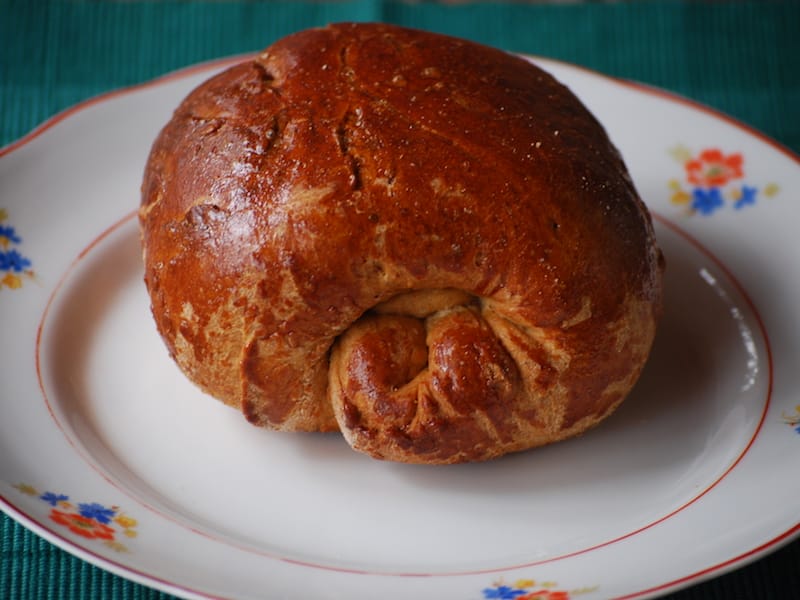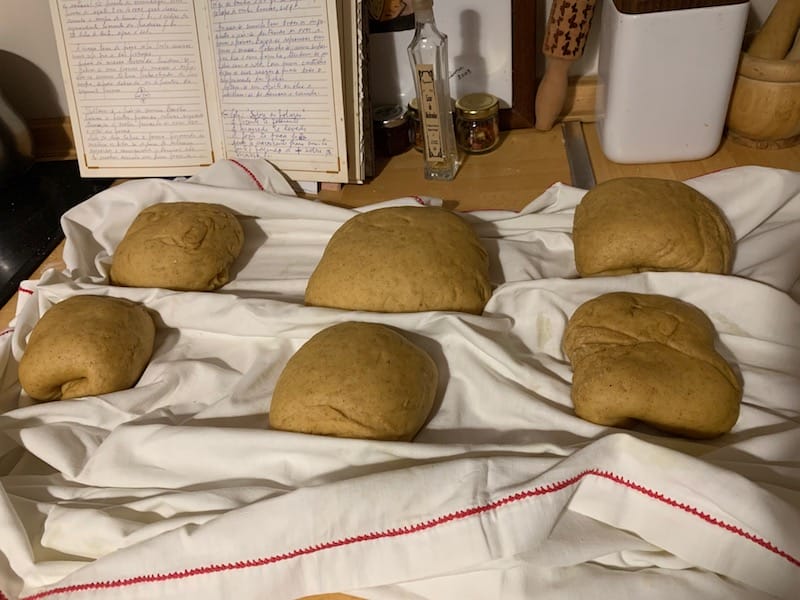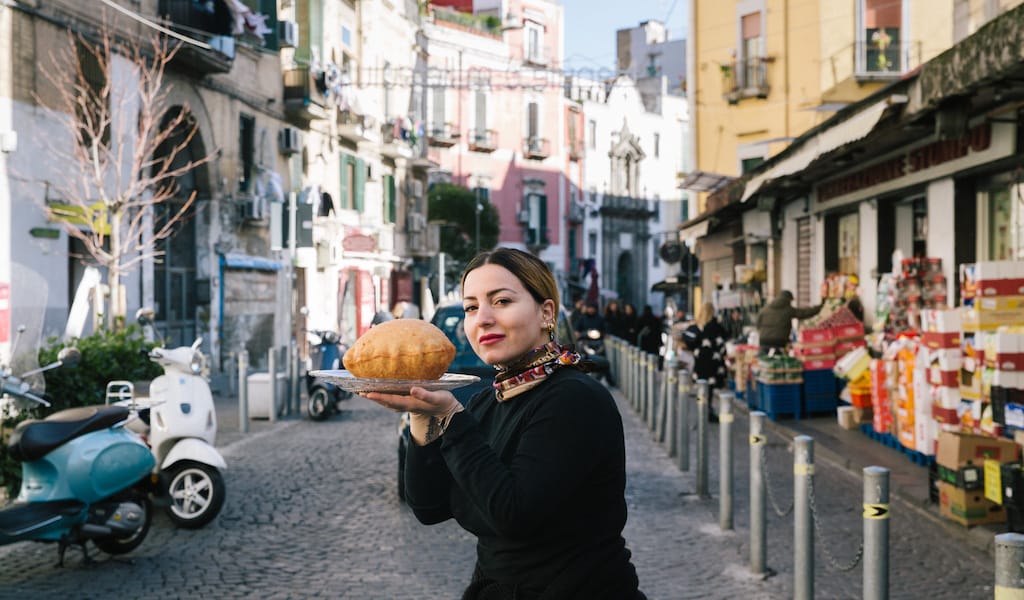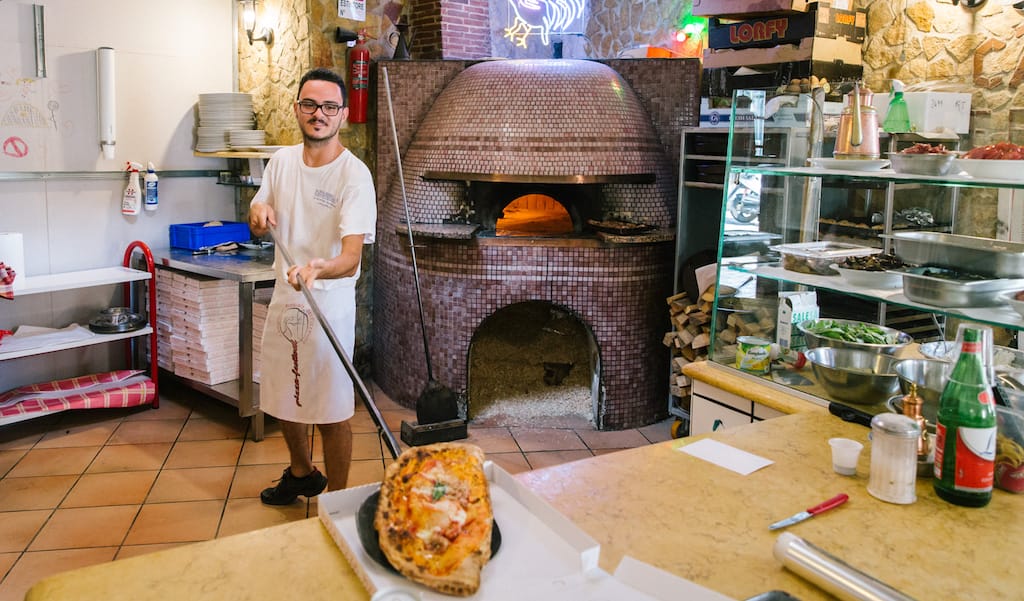Folar is the generic name given to traditional Easter sweet bread in Portugal. Making it from scratch is somewhat of a long process, but being confined due to the coronavirus crisis, we seem to have a bit more time on our hands than expected.
My family’s folar recipe is from my grandmother Felismina, who was from Rosmaninhal, near Mação (in the center of Portugal). As long as I can remember we would have this sweet bread around Easter. (A similar type of sweet bread is also baked around November 1, for All Saints’ Day.)
Like most folares, the version my family makes is from the popular baking tradition, often connected with the Catholic calendar and short on eggs and sugar, unlike the convent sweets or even other traditional cakes. Instead it incorporates generous amounts of cinnamon and aniseed. While it’s not uncommon for folar to be topped with an egg or two, which are baked in the oven together with the bread, there are no eggs on top in this version (only in the dough).

When I went shopping this week, during the lockdown, I couldn’t find yeast or flour. So I had to bake it with only one kilo of flour – this recipe calls for three kilos of flour, as you would normally bake loaves for your family and to give away – and use leftover yeast in the freezer mixed with some baking powder. In different supermarkets across the city, flour has disappeared as well as yeasts of all kinds. Suddenly, we’re all bakers. I wonder if this will became a habit or just a temporary hobby? Regardless, it’s heartening to see this renewed interest in baking – in recent years, most Portuguese have neglected family baking traditions in exchange for the pretty folar from the nearest pastelaria or supermarket. Even in small villages people aren’t baking as much anymore.
Folar has long been associated with Easter and the feasting that occurs on this holiday, as I’ve mentioned in a previous article about the delicious folar de Olhão, which has multiple layers. “After the winter months and the long fast during Lent, the Easter brings an intense activity in terms of culinary preparations and the exchange of cakes, namely the folares,” writes Mouette Barboff in her book A Tradição do Pão em Portugal (Bread in Portugal). Folares were traditionally a gift given by godfathers to their godchildren, and people would bake them at home in the days leading up to Easter. There are many different regional styles; some savory folar from northern Portugal even feature meat, sausage or sardines. But overall, the sweet version is more common.
As a kid, I spent my Easter holiday in the village of Rosmaninhal; I remember the long baking sessions, after which we would bring our loaves to a kind of community oven that belonged to a cousin. Most people had their own wood-fired ovens but once a relative had theirs started it was more convenient and sustainable to use the one that was already hot than to start up your own. My brother and I, together with my cousins, didn’t do much except eat or occasionally carry wood or loaves.
Besides the folar, regular bread was made as well, and so the baking often ended up taking a full day, as they needed time for proofing. It was incredible to taste the sweet bread fresh out of the oven – the intense smell of aniseed and cinnamon is one of my fondest childhood memories – and then to share with relatives or friends once we were back in Lisbon. In fact, it got even better after we were back home – it took on a second life as toast covered with butter or cheese. As my grandmother died early, my mother and aunt Leonor would still bake it, and more recently my cousin Paula became an expert folar-maker.
I’m not as good as they are, but this year I had time on my hands and dedicated a full day to scout the ingredients, mix them, proof the dough, shape the folar, leave it to proof again and then finally bake these loaves of sweet and spicy bread. It’s been years since my mother and I did this together, but reunited in this lockdown, we found that our love for food and cooking is stronger than ever – and that my grandmother was probably right when she said to all of us, “You never pay attention when I’m doing this, once when I’m gone these family recipes won’t be the same.”
This recipe, like most of my grandmother’s, had no exact measurements, as she had a lot of experience making it and knew all the steps and ingredients by heart. My aunt recorded this version, the one my mother and I used.
The quantities were still very loose – “a bit of olive oil” and “enough yeast” – but we nailed down some exact measurements that work well. The folar stays fresh for quite a while; but if it does start to go dry, it’s just as delicious when toasted and covered with butter, jam or cheese.
As we shaped the bread, my mother cut a cross on them and said something that her mother used to say: “May God multiply you for many people.” Across Portugal, and many other countries, this is a ritual that has been passed down from mothers to daughters for years, and I plan to keep it going.

Folar da Avó (Grandmother’s Sweet Bread)
Bakes around 6 or 7 loaves
50g yeast
1kg flour
400g sugar
70g butter
1/4 liter olive oil
2 eggs
3 tablespoons ground aniseed
2 tablespoons cinnamon
A small glass of aguardente (similar to grappa, can be any other high alcohol drink)
1/8 liter milk
Lemon zest
A pinch of salt
Dissolve the yeast in a bit of warm water and then mix in the flour. Add the sugar, butter, olive oil, and all the other ingredients. Use your hands to mix everything or use a mixer. Work on the dough for a few minutes with both hands. If it feels too dry, add a bit more of olive oil or milk. When it’s no longer sticking to your hands let it rest in a bowl covered with a tea towel for about two hours, preferably in a warm place, to proof.
Once it’s ready, shape the dough into balls a little bit bigger than the palm of your hand and then push them flat on a wooden board covered with flour. Pull on the four edges and then fold in the sequence of north, east, south and west and place upside down in a tray covered with a tablecloth. Make sure to put a cloth barrier between each loaf so that they don’t stick together. Let proof again for another two hours. Finally brush the folares with an egg yolk before putting them in a warm oven (preheated for 20 minutes at 180 degrees Celsius) and let them bake for about 20-25 minutes.
Published on April 10, 2020
Related stories
July 9, 2013
Shanghai | By Zolzaya Erdenebileg - UnTour Shanghai
ShanghaiIt’s two in the morning at Wangji Chaozhou, a rice porridge (粥, zhōu) restaurant in Changning that stays open till 5 a.m. – late even by the standards of restless Dingxi Lu, a bustling, neon-lit thoroughfare close to several college campuses. The waitress on duty is either suspicious by nature, or made more so by…
Dig into Naples’ many fried foods on our walk.
June 21, 2022
NaplesAfter a morning spent walking around the Fontanelle Cemetery, the oldest ossuary in Naples, and the Sanità market, we believe that we have created enough of a calorie deficit to face a fried pizza – the original pizza, born before the more familiar oven-baked variety, and a universally beloved dish in the Neapolitan cuisine –…
August 3, 2018
NaplesWe’ve got a thing for small, family-run spots in Naples, particularly those that are multigenerational. If a restaurant or bakery or producer has been open for at least a century and has always stubbornly stood in the same place, continuity and quality of product are all but guaranteed. Take, for instance, Cantina del Gallo in…


















































































